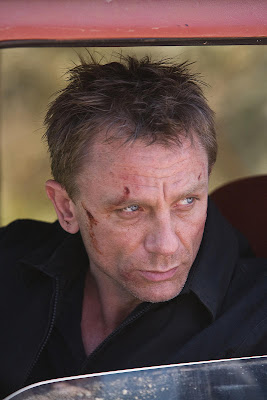 Even though he might be my least favourite contemporary director, I’ll try not to turn this review of Quantum of Solace into an exercise in bashing Marc Forster. But the question remains: who thought it would be a good idea to hand over the latest James Bond movie to a guy whose sole directorial signature is a fondness for random, off-centre framing?
Even though he might be my least favourite contemporary director, I’ll try not to turn this review of Quantum of Solace into an exercise in bashing Marc Forster. But the question remains: who thought it would be a good idea to hand over the latest James Bond movie to a guy whose sole directorial signature is a fondness for random, off-centre framing?The car chase that kicks off the film gives you a good idea of what you’re in for: a flurry of closeups of fenders, steering wheels, rear-view mirrors, Daniel Craig’s eyes, drivers of random vehicles who appear to be steering to get out of his way (or are they the people he’s chasing, steering to crash into him?), all intercut with a long shot from a camera zooming toward a highway across the surface of a lake. It’s designed to be incomprehensible — an abstraction of an action scene — much like the followup scene where a shootout in a makeshift interrogation room leads to Bond chasing a bad guy on a dizzying rooftop chase that climaxes with the two men dangling from ropes on a collapsing scaffold, furiously reaching for the guns they’ve dropped and which lie just a few tantalizing inches out of reach of their desperate fingers.
Forster doesn’t seem to care all that much if audiences can follow what’s happening in these sequences. (I sure couldn’t.) In fact, he seems to have deliberately elided a lot of the connecting shots that explain how the characters got from point A to point B. The crazy thing, though, is that I get the impression that the screenwriters and the fight choreographers really did design these sequences so that they made logical sense — I can’t help but think the stuntmen must have been furious when they screened the finished product and saw what a hash Forster and editors Matt Chesse and Richard Pearson had made of all their work.
The plot of Quantum of Solace is even murkier than the staging of the action scenes, although that may be because the screenwriters assumed I remembered the plot of Casino Royale much more vividly than I actually do. This time out, Bond is still brooding over the death of Vesper Lynd — and luckily, his mission to defeat his latest foe dovetail nicely with his thirst for revenge. A little too nicely for the tastes of M (Judi Dench), who notes with deadpan alarm the death toll her favourite agent is quickly racking up.
Daniel Craig completely commits to the franchise’s new concept of Bond as a cold-blooded brute, and Mathieu Amalric’s weasely performance as resource-hoarding CEO Dominic Green will satisfy anyone who’s ever wondered what it might look like if Roman Polanski played a Bond villain. And I guess I admire the producers’ willingness to push Bond’s behaviour to the outer borders of sociopathy. But whatever happened to the idea of the Bond movies as escapist entertainment? The Bond movies used to make being a secret agent look like the greatest job in the world (and being a supervillain the second-greatest), but in Quantum of Solace, neither Bond nor Greene seem to be having any fun at all.
Whatever happened to the outlandish spirit of Ken Adam’s witty set designs? Quantum of Solace was designed by Dennis Gassner, who’s done a lot of work with the Coen Brothers; Forster has mostly assigned him to build a lot of tasteful hotel rooms and offices, the kind that I’m sure will ignite the fantasies of jet-setting business executives the world over.
The Bond girl in Quantum of Solace is Olga Kurylenko’s Camille, who spends the whole movie planning her own grim revenge against an evil Bolivian general. (Forster fetishizes the burn mark on her back, the residue of her childhood brush with the man.) The tonal shift in Quantum compared to the classic Bonds becomes clear when Forster pays homage to the death of Shirley Eaton in Goldfinger — here, a woman is found dead in a hotel room, only this time she’s covered in oil instead of painted gold. The image of the gold-coated girl in Goldfinger was inexplicable, surreal, and oddly beautiful, like something out of a fairytale; here, it’s just an ugly, unpleasant bit of sadism.
I’m surprised to be saying all this, because I thought Casino Royale was a smashingly effective film, and a much-needed jolt of energy to a sagging franchise. But Quantum of Solace barely feels like a Bond movie, and all the familiar Bond trappings — the opening credit montage, full of guns, bullets, and naked women; the swaggering Bond theme that finally reappears under the closing credits — feel like empty traditions. A Bond movie that doesn’t even want to exhilarate you? If that’s Forster’s idea of a new Bond tradition, let’s hope the producers nip it in the bud.




0 Yorumlar